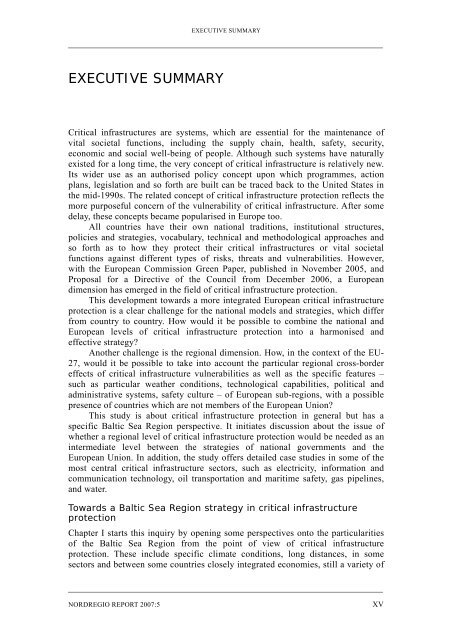Towards a Baltic Sea Region Strategy in Critical ... - Helsinki.fi
Towards a Baltic Sea Region Strategy in Critical ... - Helsinki.fi
Towards a Baltic Sea Region Strategy in Critical ... - Helsinki.fi
You also want an ePaper? Increase the reach of your titles
YUMPU automatically turns print PDFs into web optimized ePapers that Google loves.
EXECUTIVE SUMMARY<br />
EXECUTIVE SUMMARY<br />
<strong>Critical</strong> <strong>in</strong>frastructures are systems, which are essential for the ma<strong>in</strong>tenance of<br />
vital societal functions, <strong>in</strong>clud<strong>in</strong>g the supply cha<strong>in</strong>, health, safety, security,<br />
economic and social well-be<strong>in</strong>g of people. Although such systems have naturally<br />
existed for a long time, the very concept of critical <strong>in</strong>frastructure is relatively new.<br />
Its wider use as an authorised policy concept upon which programmes, action<br />
plans, legislation and so forth are built can be traced back to the United States <strong>in</strong><br />
the mid-1990s. The related concept of critical <strong>in</strong>frastructure protection reflects the<br />
more purposeful concern of the vulnerability of critical <strong>in</strong>frastructure. After some<br />
delay, these concepts became popularised <strong>in</strong> Europe too.<br />
All countries have their own national traditions, <strong>in</strong>stitutional structures,<br />
policies and strategies, vocabulary, technical and methodological approaches and<br />
so forth as to how they protect their critical <strong>in</strong>frastructures or vital societal<br />
functions aga<strong>in</strong>st different types of risks, threats and vulnerabilities. However,<br />
with the European Commission Green Paper, published <strong>in</strong> November 2005, and<br />
Proposal for a Directive of the Council from December 2006, a European<br />
dimension has emerged <strong>in</strong> the <strong>fi</strong>eld of critical <strong>in</strong>frastructure protection.<br />
This development towards a more <strong>in</strong>tegrated European critical <strong>in</strong>frastructure<br />
protection is a clear challenge for the national models and strategies, which differ<br />
from country to country. How would it be possible to comb<strong>in</strong>e the national and<br />
European levels of critical <strong>in</strong>frastructure protection <strong>in</strong>to a harmonised and<br />
effective strategy?<br />
Another challenge is the regional dimension. How, <strong>in</strong> the context of the EU-<br />
27, would it be possible to take <strong>in</strong>to account the particular regional cross-border<br />
effects of critical <strong>in</strong>frastructure vulnerabilities as well as the speci<strong>fi</strong>c features –<br />
such as particular weather conditions, technological capabilities, political and<br />
adm<strong>in</strong>istrative systems, safety culture – of European sub-regions, with a possible<br />
presence of countries which are not members of the European Union?<br />
This study is about critical <strong>in</strong>frastructure protection <strong>in</strong> general but has a<br />
speci<strong>fi</strong>c <strong>Baltic</strong> <strong>Sea</strong> <strong>Region</strong> perspective. It <strong>in</strong>itiates discussion about the issue of<br />
whether a regional level of critical <strong>in</strong>frastructure protection would be needed as an<br />
<strong>in</strong>termediate level between the strategies of national governments and the<br />
European Union. In addition, the study offers detailed case studies <strong>in</strong> some of the<br />
most central critical <strong>in</strong>frastructure sectors, such as electricity, <strong>in</strong>formation and<br />
communication technology, oil transportation and maritime safety, gas pipel<strong>in</strong>es,<br />
and water.<br />
<strong>Towards</strong> a <strong>Baltic</strong> <strong>Sea</strong> <strong>Region</strong> strategy <strong>in</strong> critical <strong>in</strong>frastructure<br />
protection<br />
Chapter I starts this <strong>in</strong>quiry by open<strong>in</strong>g some perspectives onto the particularities<br />
of the <strong>Baltic</strong> <strong>Sea</strong> <strong>Region</strong> from the po<strong>in</strong>t of view of critical <strong>in</strong>frastructure<br />
protection. These <strong>in</strong>clude speci<strong>fi</strong>c climate conditions, long distances, <strong>in</strong> some<br />
sectors and between some countries closely <strong>in</strong>tegrated economies, still a variety of<br />
NORDREGIO REPORT 2007:5<br />
XV

















